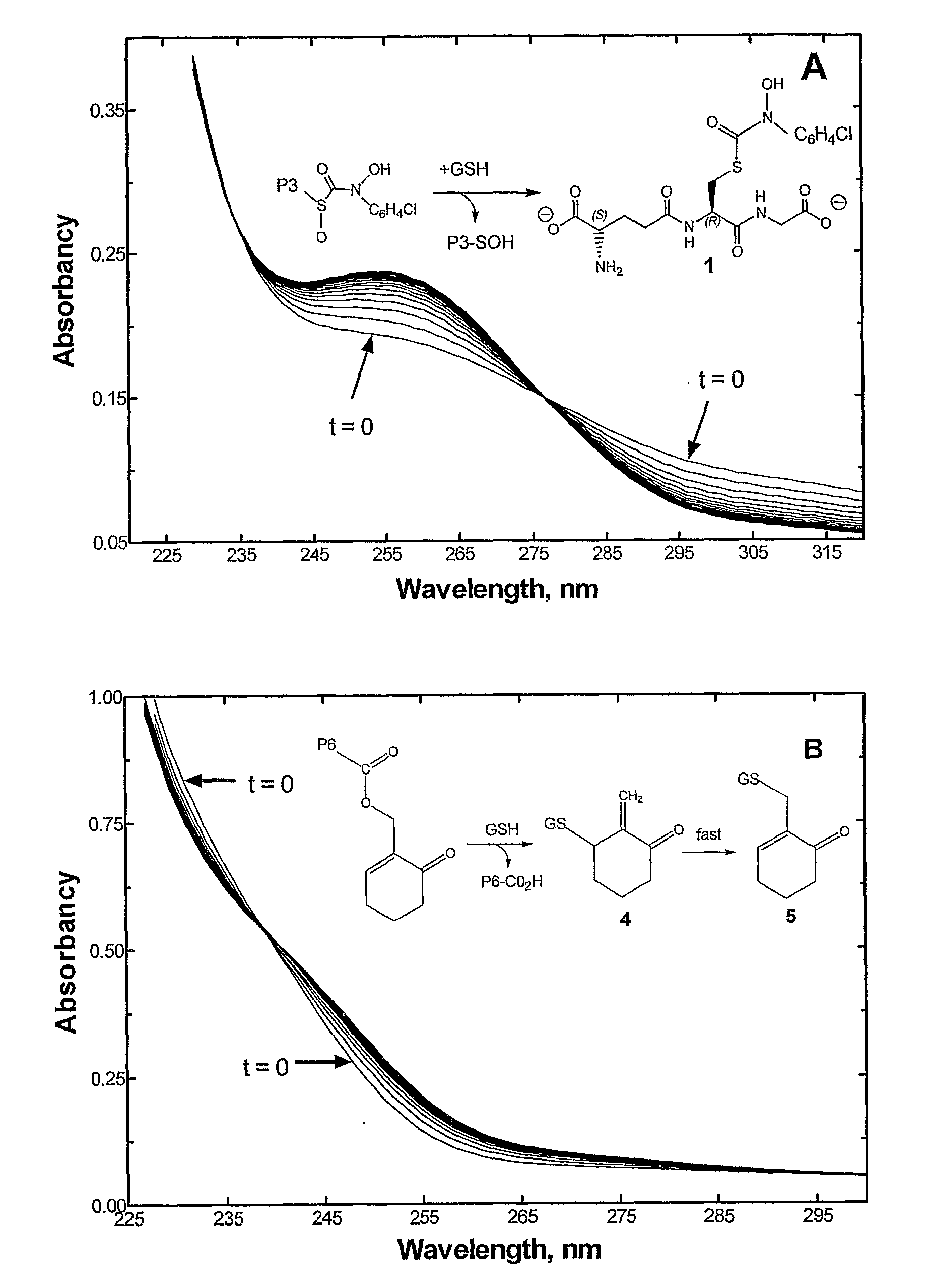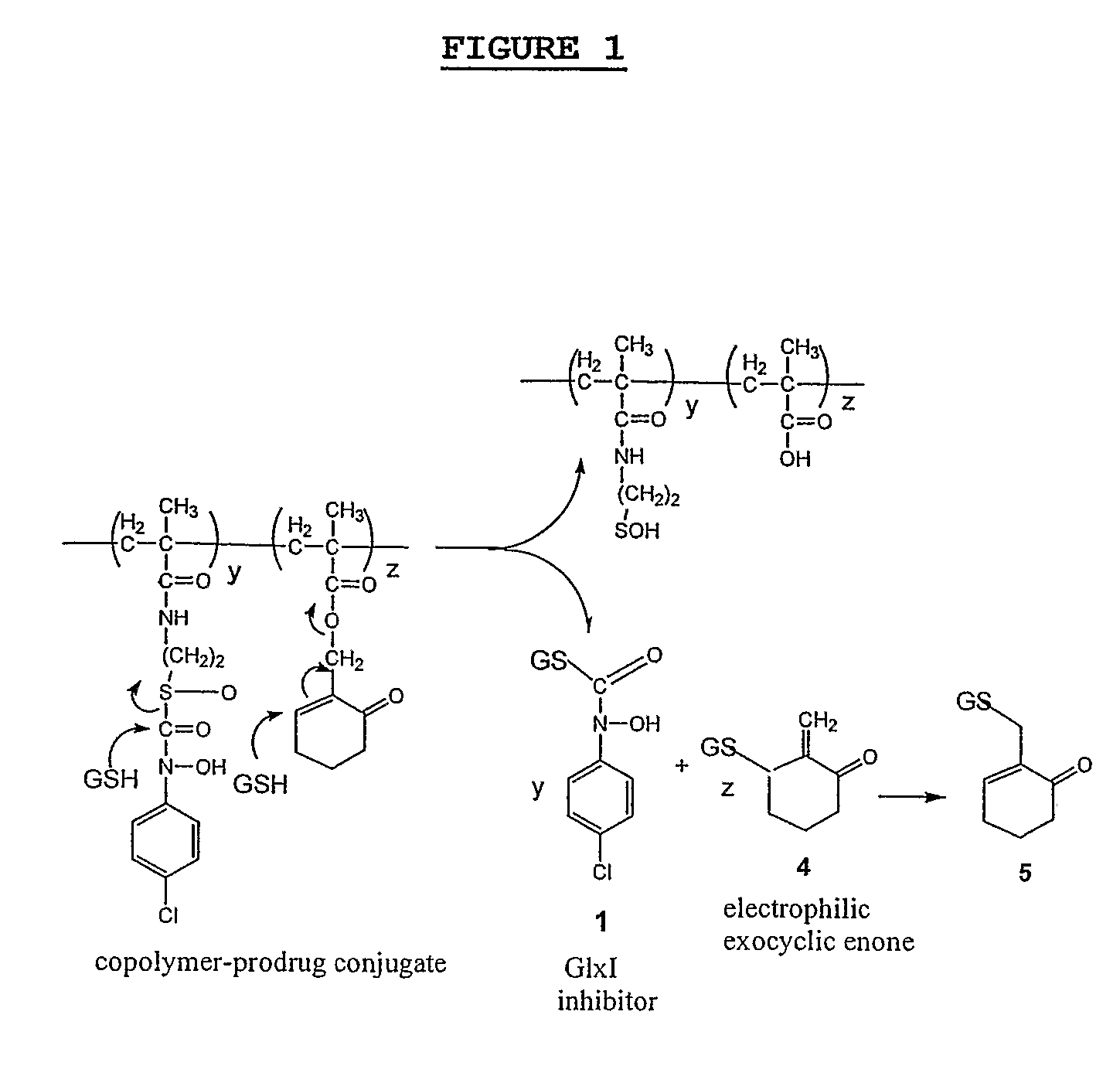Macromolecular Gsh-Activiated Glyoxylase I Inhibitors
a technology of glyoxylase and macromolecular prodrugs, which is applied in the direction of anthracene dyes, drug compositions, peptides, etc., can solve the problems of adversely affecting rapidly dividing normal cells, adverse effects of antitumor agents currently in use, and inability to specifically deliver antitumor agents to tumor tissue, etc., to achieve the effect of effectively inhibiting the proliferation of tumor cells
- Summary
- Abstract
- Description
- Claims
- Application Information
AI Technical Summary
Benefits of technology
Problems solved by technology
Method used
Image
Examples
example 1
Synthesis of Compounds and HPMA Copolymers
[0112] S—(N-4-Chlorophenyl-N-hydroxycarbamoyl)thioethylamine (shown as (9) in FIG. 2) was synthesized from the corresponding ethyl sulfoxide prodrug using the following procedure.
[0113] To a solution of S—(N-4-chlorophenyl-N-hydroxycarbamoyl)ethyl sulfoxide (shown as (2) in FIG. 2) (495 mg, 2 mmol) in a mixture of 12 mL methanol and 12 mL phosphate buffer (0.1 M, pH 7.5) was added a solution of cysteamine (990 mg, 12.9 mmol) in 5 mL of phosphate buffer (0.1 M, pH 7.5). The mixture was stirring at 0° C. for 1 h. The precipitate was collected by filtration, washed with water and dried under vacuum to give the final product as a white solid: Yield 86′ (424 mg). 1H NMR (300 MHz, methanol-d4 / TMS) δ 3.01 (2H, t, J=6.6 Hz), 3.50 (2H, t, J=6.6 Hz) 7.32 (2H, d, J=9.2 Hz), 7.61 (2H, d, J=9.2 Hz); HRMS (ESI) m / z 247.0294 (calc'd for C9H12N2O2SCl: 247.0308). This procedure must form the thiol ester and not the amide because the “sulfoxide” containing ...
example 2
[0139] Reactions were initiated by the introduction of ethanolic solutions of copolymer into cuvettes containing at least a 20-fold excess of GSH over the equivalents of 8-sulfoxide and / or cyclohexenyl groups in degassed / N2 saturated potassium phosphate buffer (0.1 M), pH 6.5, 25° C. Rate constants were calculated from the first-order decrease in absorbancy at 305 nm and 235 nm resulting from the loss of 8-sulfoxide and cyclohexenyl groups, respectively, FIG. 5.
[0140] Incubation of the HPMA copolymers with GSH produced a time-dependent increase in product species, which co-migrated with authentic samples of transition state analogue (i.e. compound (1)) and GSH-2-methylcyclohexenone adduct (i.e. compound (5)) monitored by reverse-phase HPLC; e.g., FIG. 5.
[0141] As shown in FIG. 6, the rate constants for formation of these species correlated well with the first-order rate of decrease in absorbancy at 305 nm and 235 nm, corresponding to the loss of the sulfox...
example 3
Stability of Copolymers in Human Serum
[0147] To 0.45 mL human serum at 37° C., was added P8 to an initial concentration of approximately 1 mM in 8-sulfoxide and cyclohexenyl groups. As a function of time, 30 μL aliquots of the incubation mixture were transferred to 20 μL of potassium phosphate buffer (0.1 M, pH 7.5) containing 1.6 mM GSH to convert the 8-sulfoxide and cyclohexenyl functions to compounds (1) and (5), respectively. After incubation at room temperature for 5 minutes, the samples were deproteinized by the addition of 100 μL ethanol. The protein precipitate was sedimented by centrifugation at 13,000 g, and the supernatant was fractionated by reverse-phase HPLC, as described in Example 2 above.
[0148] The transition state analogue, compound (1), and the GSH adduct, compound (5) were quantified, as described above in Example 2. The rate constants were calculated from the first-order rate of loss of 8-sulfoxide or cyclohexenyl groups as a function of time.
[0149] In this m...
PUM
| Property | Measurement | Unit |
|---|---|---|
| Mass | aaaaa | aaaaa |
| Mass | aaaaa | aaaaa |
| Mass | aaaaa | aaaaa |
Abstract
Description
Claims
Application Information
 Login to View More
Login to View More - R&D
- Intellectual Property
- Life Sciences
- Materials
- Tech Scout
- Unparalleled Data Quality
- Higher Quality Content
- 60% Fewer Hallucinations
Browse by: Latest US Patents, China's latest patents, Technical Efficacy Thesaurus, Application Domain, Technology Topic, Popular Technical Reports.
© 2025 PatSnap. All rights reserved.Legal|Privacy policy|Modern Slavery Act Transparency Statement|Sitemap|About US| Contact US: help@patsnap.com



